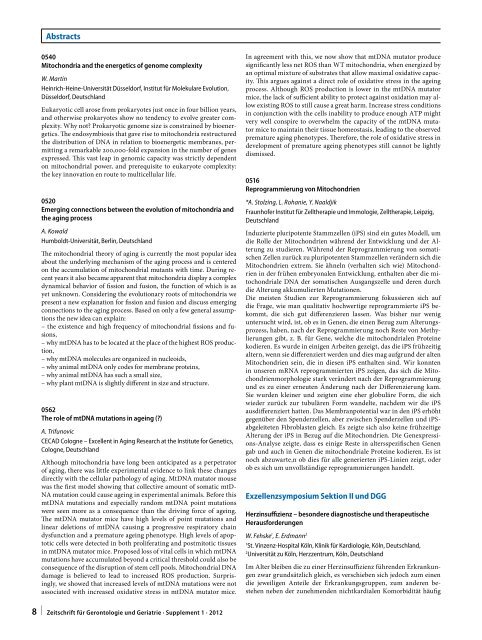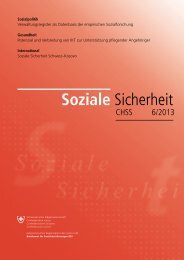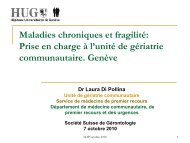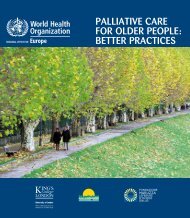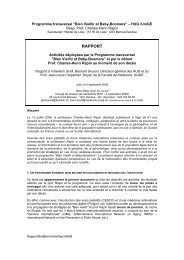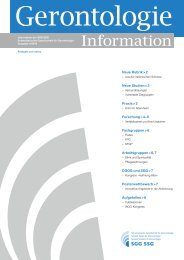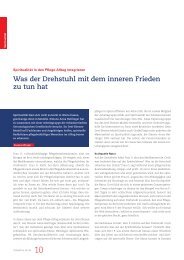Gerontologie+ Geriatrie - SGG-SSG
Gerontologie+ Geriatrie - SGG-SSG
Gerontologie+ Geriatrie - SGG-SSG
Sie wollen auch ein ePaper? Erhöhen Sie die Reichweite Ihrer Titel.
YUMPU macht aus Druck-PDFs automatisch weboptimierte ePaper, die Google liebt.
Abstracts<br />
0540<br />
Mitochondria and the energetics of genome complexity<br />
W. Martin<br />
Heinrich-Heine-Universität Düsseldorf, Institut für Molekulare Evolution,<br />
Düsseldorf, Deutschland<br />
Eukaryotic cell arose from prokaryotes just once in four billion years,<br />
and otherwise prokaryotes show no tendency to evolve greater complexity.<br />
Why not? Prokaryotic genome size is constrained by bioenergetics.<br />
The endosymbiosis that gave rise to mitochondria restructured<br />
the distribution of DNA in relation to bioenergetic membranes, permitting<br />
a remarkable 200,000-fold expansion in the number of genes<br />
expressed. This vast leap in genomic capacity was strictly dependent<br />
on mitochondrial power, and prerequisite to eukaryote complexity:<br />
the key innovation en route to multicellular life.<br />
0520<br />
Emerging connections between the evolution of mitochondria and<br />
the aging process<br />
A. Kowald<br />
Humboldt-Universität, Berlin, Deutschland<br />
The mitochondrial theory of aging is currently the most popular idea<br />
about the underlying mechanism of the aging process and is centered<br />
on the accumulation of mitochondrial mutants with time. During recent<br />
years it also became apparent that mitochondria display a complex<br />
dynamical behavior of fission and fusion, the function of which is as<br />
yet unknown. Considering the evolutionary roots of mitochondria we<br />
present a new explanation for fission and fusion and discuss emerging<br />
connections to the aging process. Based on only a few general assumptions<br />
the new idea can explain:<br />
– the existence and high frequency of mitochondrial fissions and fusions,<br />
– why mtDNA has to be located at the place of the highest ROS production,<br />
– why mtDNA molecules are organized in nucleoids,<br />
– why animal mtDNA only codes for membrane proteins,<br />
– why animal mtDNA has such a small size,<br />
– why plant mtDNA is slightly different in size and structure.<br />
0562<br />
The role of mtDNA mutations in ageing (?)<br />
A. Trifunovic<br />
CECAD Cologne – Excellent in Aging Research at the Institute for Genetics,<br />
Cologne, Deutschland<br />
Although mitochondria have long been anticipated as a perpetrator<br />
of aging, there was little experimental evidence to link these changes<br />
directly with the cellular pathology of aging. MtDNA mutator mouse<br />
was the first model showing that collective amount of somatic mtD-<br />
NA mutation could cause ageing in experimental animals. Before this<br />
mtDNA mutations and especially random mtDNA point mutations<br />
were seen more as a consequence than the driving force of ageing.<br />
The mtDNA mutator mice have high levels of point mutations and<br />
linear deletions of mtDNA causing a progressive respiratory chain<br />
dysfunction and a premature ageing phenotype. High levels of apoptotic<br />
cells were detected in both proliferating and postmitotic tissues<br />
in mtDNA mutator mice. Proposed loss of vital cells in which mtDNA<br />
mutations have accumulated beyond a critical threshold could also be<br />
consequence of the disruption of stem cell pools. Mitochondrial DNA<br />
damage is believed to lead to increased ROS production. Surprisingly,<br />
we showed that increased levels of mtDNA mutations were not<br />
associated with increased oxidative stress in mtDNA mutator mice.<br />
In agreement with this, we now show that mtDNA mutator produce<br />
significantly less net ROS than WT mitochondria, when energized by<br />
an optimal mixture of substrates that allow maximal oxidative capacity.<br />
This argues against a direct role of oxidative stress in the ageing<br />
process. Although ROS production is lower in the mtDNA mutator<br />
mice, the lack of sufficient ability to protect against oxidation may allow<br />
existing ROS to still cause a great harm. Increase stress conditions<br />
in conjunction with the cells inability to produce enough ATP might<br />
very well conspire to overwhelm the capacity of the mtDNA mutator<br />
mice to maintain their tissue homeostasis, leading to the observed<br />
premature aging phenotypes. Therefore, the role of oxidative stress in<br />
development of premature ageing phenotypes still cannot be lightly<br />
dismissed.<br />
0516<br />
Reprogrammierung von Mitochondrien<br />
*A. Stolzing, L. Rohanie, Y. Naaldjik<br />
Fraunhofer Institut für Zelltherapie und Immologie, Zelltherapie, Leipzig,<br />
Deutschland<br />
Induzierte pluripotente Stammzellen (iPS) sind ein gutes Modell, um<br />
die Rolle der Mitochondrien während der Entwicklung und der Alterung<br />
zu studieren. Während der Reprogrammierung von somatischen<br />
Zellen zurück zu pluripotenten Stammzellen verändern sich die<br />
Mitochondrien extrem. Sie ähneln (verhalten sich wie) Mitochondrien<br />
in der frühen embryonalen Entwicklung, enthalten aber die mitochondriale<br />
DNA der somatischen Ausgangszelle und deren durch<br />
die Alterung akkumulierten Mutationen.<br />
Die meisten Studien zur Reprogrammierung fokussieren sich auf<br />
die Frage, wie man qualitativ hochwertige reprogrammierte iPS bekommt,<br />
die sich gut differenzieren lassen. Was bisher nur wenig<br />
untersucht wird, ist, ob es in Genen, die einen Bezug zum Alterungsprozess,<br />
haben, nach der Reprogrammierung noch Reste von Methylierungen<br />
gibt, z. B. für Gene, welche die mitochondrialen Proteine<br />
kodieren. Es wurde in einigen Arbeiten gezeigt, das die iPS frühzeitig<br />
altern, wenn sie differenziert werden und dies mag aufgrund der alten<br />
Mitochondrien sein, die in diesen iPS enthalten sind. Wir konnten<br />
in unseren mRNA reprogrammierten iPS zeigen, das sich die Mitochondrienmorphologie<br />
stark verändert nach der Reprogrammierung<br />
und es zu einer erneuten Änderung nach der Differenzierung kam.<br />
Sie wurden kleiner und zeigten eine eher globuläre Form, die sich<br />
wieder zurück zur tubulären Form wandelte, nachdem wir die iPS<br />
ausdifferenziert hatten. Das Membranpotential war in den iPS erhöht<br />
gegenüber den Spenderzellen, aber zwischen Spenderzellen und iPSabgeleiteten<br />
Fibroblasten gleich. Es zeigte sich also keine frühzeitige<br />
Alterung der iPS in Bezug auf die Mitochondrien. Die Genexpressions-Analyse<br />
zeigte, dass es einige Reste in altersspezifischen Genen<br />
gab und auch in Genen die mitochondriale Proteine kodieren. Es ist<br />
noch abzuwarte,n ob dies für alle generierten iPS-Linien zeigt, oder<br />
ob es sich um unvollständige reprogrammierungen handelt.<br />
Exzellenzsymposium Sektion II und DGG<br />
Herzinsuffizienz – besondere diagnostische und therapeutische<br />
Herausforderungen<br />
W. Fehske 1 , E. Erdmann 2<br />
1<br />
St. Vinzenz-Hospital Köln, Klinik für Kardiologie, Köln, Deutschland,<br />
2<br />
Universität zu Köln, Herzzentrum, Köln, Deutschland<br />
Im Alter bleiben die zu einer Herzinsuffizienz führenden Erkrankungen<br />
zwar grundsätzlich gleich, es verschieben sich jedoch zum einen<br />
die jeweiligen Anteile der Erkrankungsgruppen, zum anderen bestehen<br />
neben der zunehmenden nichtkardialen Komorbidität häufig<br />
8 | Zeitschrift für Gerontologie und <strong>Geriatrie</strong> · Supplement 1 · 2012


